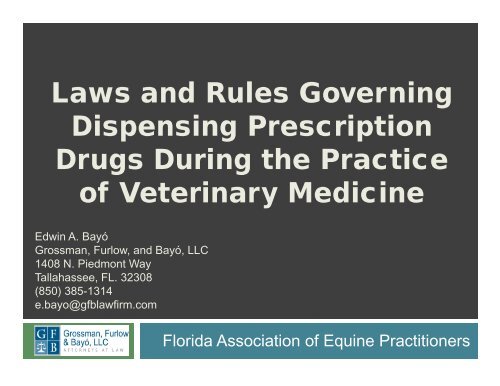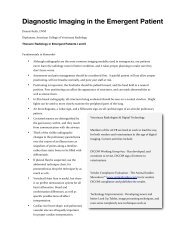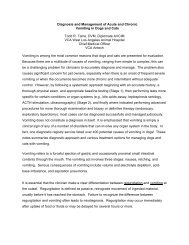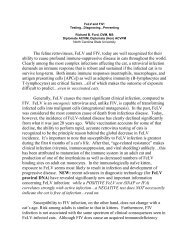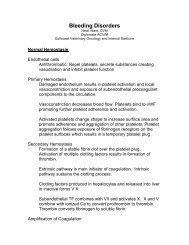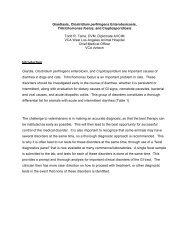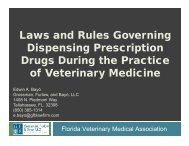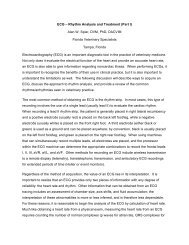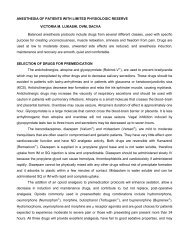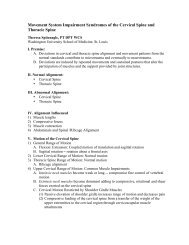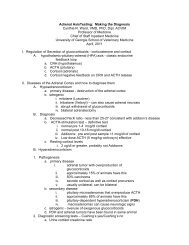Dispensing Legend Drugs
Dispensing Legend Drugs
Dispensing Legend Drugs
Create successful ePaper yourself
Turn your PDF publications into a flip-book with our unique Google optimized e-Paper software.
Laws and Rules Governing<br />
<strong>Dispensing</strong> i Prescription<br />
<strong>Drugs</strong> During the Practice<br />
of Veterinary Medicine<br />
Edwin A. Bayó<br />
Grossman, Furlow, and Bayó, LLC<br />
1408 N. Piedmont Way<br />
Tallahassee, FL. 32308<br />
(850) 385-1314<br />
e.bayo@gfblawfirm.com<br />
Florida Association of Equine Practitioners
Section 1<br />
Veterinary Prescription <strong>Drugs</strong>
Veterinary Prescription <strong>Drugs</strong><br />
Veterinary prescription drugs are labeled for use<br />
only by or on the order of a licensed<br />
veterinarian.<br />
Veterinary prescription drugs are used or<br />
prescribed only within the context of a valid<br />
veterinarian/client/patient relationship (VCPR).<br />
A veterinarian can be disciplined for “using the<br />
privilege of ordering, prescribing, or making<br />
available medicinal drugs” outside of a VCPR.<br />
§474.214(1)(y), F.S.
Veterinary Prescription <strong>Drugs</strong><br />
<br />
<br />
Veterinary yprescription<br />
p<br />
drugs must be properly<br />
labeled before being<br />
dispensed. dspe sed<br />
Appropriate dispensing<br />
and treatment records<br />
must be maintained, and<br />
veterinary prescription<br />
drugs should be<br />
dispensed d only in<br />
quantities required for<br />
the treatment of the<br />
animal(s) for which the<br />
drugs are dispensed.
Veterinarian/Client/Patient<br />
Relationship<br />
A VCPR exists when all of the following<br />
conditions have been meet:<br />
1. The veterinarian has sufficient knowledge of the<br />
animal(s) to initiate at least a general or<br />
preliminary diagnosis of the medical condition of<br />
the animal(s), which h means that t the veterinarian<br />
i<br />
is personally acquainted with the keeping and<br />
caring of the animal(s) and has seen the<br />
animal(s) or has made medically appropriate<br />
and timely visits to the premises where the<br />
animal(s) are kept.
Veterinarian/Client/Patient<br />
Relationship (continued)…<br />
2 The veterinarian is available or provides for<br />
2. The veterinarian is available or provides for<br />
follow up care and treatment in case of an<br />
adverse reaction or failure of the regimen of<br />
therapy.<br />
3. Maintains records which document patient<br />
visits, diagnosis, treatment, and other relevant<br />
information.
Section 2<br />
Federal Laws
U.S. Drug Enforcement<br />
Agency
DEA Registration<br />
In order for Florida licensed veterinarians to be<br />
able to prescribe, administer or dispense<br />
controlled substances, they must be registered<br />
with the U.S. Drug Enforcement Agency (DEA).<br />
DEA Form-224<br />
Available online and can be submitted electronically:<br />
www.deadiversion.usdoj.gov/drugreg/process.htm<br />
Send by U.S. Mail:<br />
DEA Registration ti Unit<br />
Registration Section/ODR<br />
P.O. Box 2639<br />
Springfield, VA 22152-2639
Source: An Informational Outline of the Controlled Substances Act (2006 ed.)
DEA Registration<br />
Veterinarians who practice at multiple locations<br />
must be registered with the DEA at each location.<br />
The only exception is the practitioner who uses or<br />
dispenses controlled substances as an agency of<br />
a veterinarian who is registered at each location.<br />
You must furnish your DEA registration number to<br />
obtain Schedule III, IV, and V controlled<br />
substances from suppliers. Veterinarians must<br />
use DEA Triplicate Order Form-222 to obtain<br />
Schedule II substances.
DEA Registration: Mobile<br />
Clinics<br />
Veterinarians who<br />
operate mobile clinics<br />
would be registered at<br />
the location where the<br />
controlled substances<br />
are stored.<br />
Records should be<br />
maintained as if the<br />
mobile unit were part<br />
of the registrant’s<br />
permanent location.
DEA Registration Modification<br />
Practitioners who wish to modify their Drug<br />
Enforcement Administration Registration for a<br />
name change or change of address should let<br />
their local DEA office know ahead of time, so<br />
appropriate registration changes can be made.<br />
Information concerning the DEA registration<br />
process can also be obtained by contacting<br />
the Registration Call Center at (800) 882-<br />
9539.
DEA Registration Renewal<br />
The DEA Form 224a is currently available online.<br />
Renewal applications are mailed automatically to<br />
the registered location 60 days prior to the<br />
expiration date.<br />
Any changes of address must be reported in<br />
writing to the DEA at the time the change occurs<br />
so that the renewal application will be sent to the<br />
correct address.<br />
Renewal applications will not be forwarded by the<br />
Post Office. If you are moving to a new state, t the<br />
DEA asks that you submit a copy of the new state<br />
license and a copy of the state controlled<br />
substance bt registration. it ti
DEA Registration Renewal<br />
Certificates must renewed every three (3)<br />
years.<br />
Cost of the registration fee, background check,<br />
etc. are the responsibility of the requesting<br />
veterinarian.
Source: An Informational Outline of the Controlled Substances Act (2006 ed.)
DEA Inspections<br />
<br />
<br />
The DEA does not routinely<br />
investigate t veterinary clinics, i but if<br />
an inspection does take place,<br />
organization and accurate records<br />
are essential. The DEA’s descent<br />
on a clinic will not allow the<br />
owner(s) time to search for files-<br />
one must be able to immediately<br />
access critical information.<br />
Situations that may provoke an<br />
investigation include those<br />
involving unusual prescribing<br />
practices, reports of controlled<br />
substance abuse, diversion, or<br />
other illegal activity.
DEA Identification of<br />
Controlled Substances<br />
Controlled substances are labeled with a<br />
large “C” and contain a roman numeral in<br />
the center to identify the schedule of the<br />
substance.<br />
The drugs and drug products that come<br />
under the jurisdiction of the Controlled<br />
Substance Act are divided into 5 schedules.<br />
These schedules are:
Controlled Substances Act:<br />
Drug Scheduling<br />
Schedule Description: Examples:<br />
I.<br />
The drug or other substance has a high<br />
potential for abuse. The drug or other<br />
substance has no currently accepted<br />
medical use in treatment in the United<br />
States.<br />
GHB, Heroin, Cannabis,<br />
Ecstasy, LSD.<br />
II.<br />
The drug or other substance has a high<br />
potential for abuse. The drug or other<br />
substance has a currently accepted<br />
medical use in treatment in the United<br />
States or a currently accepted medical<br />
use with severe restrictions. Abuse of<br />
the drug or other substances may lead<br />
to severe psychological l or physical<br />
dependence<br />
Cocaine, Codeine,<br />
Opium, Oxycodone,<br />
Morphine, Dexedrine.
Controlled Substances Act:<br />
Drug Scheduling (continued)<br />
Schedule Description: Examples:<br />
III.<br />
The drug or other substance has a<br />
potential for abuse less than the drugs<br />
or other substances in Schedules I and<br />
II. The drug or other substance has a<br />
currently accepted medical use in<br />
treatment in the United States. Abuse<br />
of the drug or other substance may<br />
lead to moderate or low physical<br />
dependence or high psychological<br />
dependence.<br />
Anabolic steroids;<br />
Intermediate-acting<br />
barbiturates, such as<br />
talbutal or butalbital;<br />
Buprenorphine;<br />
Ketamine; Xyrem;<br />
Hydrocodone / codeine,<br />
when compounded with<br />
an NSAID
Controlled Substances Act:<br />
Drug Scheduling (continued)<br />
Schedule Description: Examples:<br />
IV.<br />
The drug or other substance has a low<br />
potential for abuse relative to the drugs<br />
or other substances in Schedule III.<br />
The drug or other substance has a<br />
currently accepted medical use in<br />
treatment in the United States.<br />
Abuse of the drug or other substance<br />
may lead to limited physical<br />
dependence or psychological<br />
dependence relative to the drugs or<br />
other substances in Schedule III.<br />
Xanax, Stadol, Librium,<br />
Klonopin, Ativan, Restoril,<br />
Ambien, Serax
Controlled Substances Act:<br />
Drug Scheduling (continued)<br />
Schedule Description: Examples:<br />
V.<br />
The drug or other substance has a low<br />
potential for abuse relative to the drugs<br />
or other substances in Schedule IV.<br />
The drug or other substance has a<br />
currently accepted medical use in<br />
treatment in the United States.<br />
Abuse of the drug or other substance<br />
may lead to limited physical<br />
dependence or psychological<br />
dependence relative to the drugs or<br />
other substances in Schedule IV<br />
Cough suppressants<br />
containing small amounts<br />
of codeine (e.g.,<br />
promethazine+codeine);<br />
Preparations containing<br />
small amounts of opium<br />
or diphenoxylate (used to<br />
treat diarrhea);<br />
Pyrovalerone.
Ordering Controlled<br />
Substances<br />
Due to their potential for addiction, Schedule II<br />
drugs get more attention during their<br />
manufacturing, distribution, and dispensing.<br />
To order Schedule II substances, a federal<br />
triplicate order form must be used. These<br />
forms can be obtained by requesting them on<br />
the initial application form (DEA-224) by<br />
checking block “3.”<br />
They may also be obtained from the DEA<br />
Registration Unit in Washington, D.C. or online<br />
at https://www.deadiversion.usdoj.gov.<br />
di i d
Ordering Controlled<br />
Substances<br />
When using the DEA Triplicate Order Form-<br />
222 to obtain Schedule II substances, be sure<br />
to:<br />
Fill out the correctly or it will be sent back to the<br />
supplier.<br />
Fill in the “number of packages” and the “date<br />
received” sections.
Source: An Informational Outline of the Controlled Substances Act (2006 ed.)
Ordering Controlled<br />
Substances<br />
All other controlled substances are ordered in the<br />
same manner as any other medication. The<br />
supplier will ask for a copy of your current DEA<br />
registration form.<br />
There are no special requirements for Schedule<br />
III, IV, and V purchases.<br />
Obtaining controlled substances from a local<br />
pharmacy for “in-house” or “re-sale” use is<br />
prohibited.<br />
Prescriptions for controlled substances to be filled<br />
by a local pharmacy should be written only for<br />
specific patients.
DEA Records and<br />
Prescriptions<br />
Veterinarians must keep records for all<br />
controlled substances used or dispensed.<br />
These must be kept for 3 years by Florida law.<br />
Records for Schedule III, IV, and V controlled<br />
substances can be maintained as part of<br />
patient t records, by must be readily retrievable.<br />
Schedule II records must be kept separately.<br />
You must maintain i records or invoices i of<br />
controlled substances received for a 2 year<br />
period after the last quantity of each controlled<br />
substance on the invoice has been depleted.
DEA Records and<br />
Prescriptions<br />
You might be required to keep a copy of each<br />
prescription issued. Although the DEA does<br />
not require registrants to keep records of<br />
prescriptions issued, approximately 40% of<br />
states require multiple copies of controlled<br />
substance prescriptions.<br />
Prescriptions for Schedule II drugs must be in<br />
writing and cannot be refilled. Prescriptions<br />
for Schedule III or IV may be issued orally or in<br />
writing and can be refilled only up to five times<br />
in 6 months.
DEA Records and<br />
Prescriptions<br />
In emergencies, a<br />
pharmacist may fill<br />
oral prescriptions for<br />
Schedule II drugs<br />
but must notify the<br />
DEA if a written<br />
prescription order is<br />
not received within<br />
72 hours.
DEA: Biennial Inventory<br />
In addition to an initial inventory, yyou must make a<br />
biennial inventory of all controlled substances on<br />
hand. The inventory must be made every 2 years<br />
from initial registration and opening inventory.<br />
The following information should be included:<br />
1. Name, address, and registration number of each<br />
registrant.<br />
2. Name, unit size, and total quantity of each controlled<br />
substance.<br />
3. Date and time of inventory.<br />
4. Signature of person(s) making the inventory<br />
5. Separate records for Schedule II drugs.<br />
6. And new controlled drugs introduced must be put on<br />
inventory list with quantity and date.
DEA: Transfers of<br />
Controlled Substances<br />
You may transfer or receive a limited amount of<br />
controlled substances to or from another<br />
practitioner if you are both DEA registrants. Both<br />
registrants must maintain records of the<br />
transaction.<br />
Records of Schedule II controlled substance<br />
transfers must be kept on DEA Order Form-222.<br />
Records of Schedule III, IV, and V controlled<br />
substances bt may be in the form of finvoices.<br />
i<br />
The total amount transferred by a registrant must<br />
not be more that 5% of the total number of dosage<br />
units used, dispensed, or prescribed during the<br />
same calendar year.
DEA: Safety Requirements<br />
You must keep<br />
controlled<br />
substances in a<br />
securely locked,<br />
substantially<br />
constructed cabinet<br />
or safe.
DEA: Safety Requirements<br />
If a moveable lock-box is used, it must be<br />
securely affixed to a wall, floor, or cabinet.<br />
Similarly, lightweight filling cabinets or fire<br />
safes are inappropriate since they can be<br />
easily picked up and removed.<br />
Mobile units should be stocked with only<br />
enough of each controlled drug necessary for<br />
basic operation.<br />
Excess supplies should remain in a fixed<br />
secure location.
DEA: Safety Requirements<br />
There are no additional security requirements<br />
for vehicles other than a substantial container<br />
must be used if the vehicle is unsupervised<br />
(i.e.. parking lot or store).<br />
Keeping drugs in a bag is not adequate. If the<br />
vehicle is not equipped with locking bins or<br />
compartments, then a small lockable box<br />
should be affixed to the vehicle.<br />
It is not necessary to remove the drugs from<br />
the vehicle for storage if a strong, non-<br />
moveable safe box is available.
DEA: Safety Recommendations<br />
It is recommended that the controlled<br />
substance stocks be kept to a minimum.<br />
Should it be necessary to have a substantial<br />
quantity of controlled substances stored in the<br />
clinic, the DEA encourages having security,<br />
which exceeds the minimum requirements,<br />
such as a large safe and alarm system.<br />
Access to the controlled substance storage<br />
area should be restricted to the absolute<br />
minimum number of employees.
DEA: Accountability of<br />
Controlled Substances<br />
Whenever a practice administers a controlled<br />
substance to a patient, it must be recorded<br />
both on the patient’s medical record AND a<br />
“readily retrievable” log or controlled<br />
substance record.<br />
See §893.07, F.S.- Records
DEA: Theft And Loss Reporting<br />
You must report thefts or other losses of<br />
controlled substances or records promptly to<br />
the DEA.<br />
Completing DEA Form-106 is required in such<br />
cases.
DEA Form-106 Report of Theft or<br />
Loss of Controlled Substances<br />
Source: An Informational Outline of the Controlled Substances Act (2006 ed.)
U.S. Food and Drug<br />
Administration
Food, Drug, & Cosmetic Act<br />
Under the FD&C section of Title 21 of the<br />
United States Code, the FDA’s Center for<br />
Veterinary Medicine has been given the<br />
authority to govern the manufacture,<br />
distribution, and use of veterinary drugs that<br />
are distributed between states.<br />
The Federal Code also gives the FDA the<br />
authority to write regulations on how it will<br />
enforce the FD&C Act. Those regulations are<br />
contained in the Code of Federal Regulations<br />
Title 21.
The Food and Drug<br />
Modernization Act of 1997<br />
Signed into law in November of 1997 and fully<br />
enacted in April of 1999, the Act (among many<br />
other things) called for:<br />
A reduction in the time for the approval of new<br />
pharmaceutical drugs.<br />
Relaxed medical device regulations.<br />
Restricted the advertising of compounded<br />
drugs, i.e. mixtures made up by pharmacists.<br />
This provision was overturned by the US<br />
Supreme Court in 2002 on grounds of freedom<br />
of speech.
Obtaining Approval: New<br />
Animal Drug Applications<br />
Section 512 of the FD&C Act outlines the rules<br />
that govern the safety and efficacy of new<br />
animal drugs.<br />
The Code of Federal Regulations (CFR)<br />
details the requirements of submissions<br />
demonstrating the safety and efficacy of a drug<br />
before approval can be granted.<br />
The new animal drug approval (NADA)<br />
process is extremely complicated and has so<br />
far proved a very effective safeguard.
Extra-Label Drug Use (ELDU)<br />
"Extra-label use" is defined as:<br />
"Actual use or intended use of a drug in an<br />
animal in a manner that is not in accordance<br />
with the approved labeling. This includes, but<br />
is not limited to, use in species not listed in the<br />
labeling, use for indications (disease and other<br />
conditions) not listed in the labeling, use at<br />
dosage levels, frequencies, or routes of<br />
administration other than those stated in the<br />
labeling, li and deviation from labeled l withdrawal<br />
time based on these different uses."
Extra-Label Drug Use<br />
Under the provisions of the Animal Medicinal<br />
Drug Use Clarification Act of 1994, the FDA<br />
recognizes the professional judgment of<br />
veterinarians, i and allows the extra-label l use of<br />
drugs by veterinarians under certain conditions<br />
(21 CFR 530).<br />
Any drug used in an extra-label manner is by<br />
definition a prescription p drug since the<br />
involvement of a veterinarian is required.<br />
Extra-label use of drugs may only take place<br />
within the scope of a valid veterinarian-client-<br />
i t<br />
patient relationship (VCPR)
Extra-Label Drug Use<br />
In the absence of a<br />
valid VCPR, if an<br />
approved new animal<br />
drug is used for a use<br />
for which it is not<br />
labeled, such use has<br />
caused dthe drug to be<br />
deemed unsafe and<br />
therefore adulterated<br />
under the Act (21<br />
U.S.C. 351(a)(5)).
Extra-Label Drug Use<br />
The FDA has taken legal action against<br />
veterinarians who were responsible for<br />
creating violative drug tissue residues in the<br />
human food supply, especially when these<br />
were the result of drugs used contrary to label<br />
instructions.<br />
Nevertheless, extra-label drugs used in<br />
treating food-producing animals may be<br />
considered by a veterinarian when the health<br />
of animals is immediately threatened and<br />
suffering or death would result from failure to<br />
treat the affected animals.
Labeling of drugs prescribed<br />
for extra-label use<br />
At a minimum, the following label information is recommended:<br />
1. The name and address of the prescribing veterinarian.<br />
2. The established name of the drug (active ingredient), or if<br />
formulated from more than one ingredient, the established<br />
name of each ingredient.<br />
3. Any directions for use specified by the practitioner (including<br />
class/species or identification of the animals; dosage,<br />
frequency, and route of administration; and, duration of<br />
therapy).<br />
4. Any cautionary statements specified by the veterinarian.<br />
5. The veterinarian's specified withdrawal/discard time(s) for<br />
meat, milk, eggs, or any food which h might be derived d from<br />
the treated animals.
<strong>Drugs</strong> Prohibited for Extra-<br />
Label Use in Food Animals:<br />
Chloramphenicol; Sulfonamide drugs in<br />
Clenbuterol;<br />
lactating dairy cattle<br />
(except approved use<br />
Diethylstilbestrol<br />
of sulfadimethoxine,<br />
(DES);<br />
sulfabromomethazine,<br />
Dimetridazole;<br />
and<br />
<br />
Ipronidazole;<br />
sulfaethoxypyridazine);<br />
i Other nitroimidazoles; Fluoroquinolones;<br />
<br />
Furazolidone;<br />
<br />
Phenylbutazone in<br />
Nitrofurazone;<br />
female dairy cattle 20<br />
months of age or older.<br />
<br />
Glycopeptides;
Compounding Under<br />
AMDUCA<br />
Animal Medicinal Drug Use Clarification Act<br />
The extra-label drug use regulation also<br />
provides for the legal compounding of animal<br />
drugs from approved animal drugs and<br />
approved human drugs. The compounding<br />
must be in compliance with the provisions of<br />
this regulation. The regulation provides<br />
additional requirements for extra-label<br />
compounding (21 CFR 530.13).<br />
The extra-label drug use regulation does not<br />
allow for legal l animal drug compounding from<br />
active pharmaceutical ingredients (bulk drugs).
Human-Label Drug Products<br />
Veterinarians, as licensed health professionals,<br />
must have the right to purchase or prescribe<br />
human-labeled prescription drugs and to use them<br />
according to their best medical judgment in<br />
compliance with relevant laws and regulations.<br />
The FDA has confirmed that manufacturers may<br />
legally sell human-labeled prescriptions drugs to<br />
veterinarians upon their order.<br />
Veterinarians have full responsibility when using<br />
human-labeled prescription products in the<br />
treatment of animals, and must recognize that<br />
manufacturers cannot promote the sale of those<br />
products to veterinarians.
Adulterated <strong>Drugs</strong><br />
Under Section 301 of the FD&C Act, the<br />
introduction or delivery into interstate commerce<br />
of any food, drug, device, or cosmetic that is<br />
adulterated is prohibited.<br />
Section 501 of Title 21 defines what constitutes an<br />
adulterated drug.<br />
Simply stated, drugs that contain unsanitary<br />
components, lack adequate control in<br />
manufacture, differ in strength th from that<br />
t<br />
recognized in the official compendium, or that are<br />
mixed with another substance to reduce their<br />
quality or strength are considered to have been<br />
adulterated.
Compounding<br />
The Federal Food, Drug, and Cosmetic Act (the<br />
Act) does not distinguish compounding from<br />
manufacturing or other processing of drugs for<br />
use in animals.<br />
FDA acknowledges the use of compounding<br />
within certain areas of veterinary practice.<br />
The current state of veterinary medicine requires<br />
products to treat many conditions in a number of<br />
different species, some of which are known to<br />
have unique physiological characteristics.<br />
Furthermore, FDA regulations specifically permit<br />
the compounding of products from approved<br />
animal or human drugs under the conditions set<br />
forth in 21 CFR 530.13.
Compounding<br />
However, the FDA is<br />
greatly concerned<br />
about veterinarians and<br />
pharmacies that are<br />
engaged in<br />
manufacturing and<br />
distributing unapproved<br />
new animal drugs in a<br />
manner that is clearly<br />
outside the bounds of<br />
traditional pharmacy<br />
practice and that<br />
violates the Act
Compounding<br />
With regard to compounding from bulk drug<br />
substances, two Federal Appeals Court<br />
decisions, United States v. Algon Chemical<br />
Inc., 879 F.2d 1154 (3d Cir. 1989) and United<br />
States v. 9/1 Kg. Containers, 854 F.2d 173 (7th<br />
Cir. 1988), affirmed the FDA position that the<br />
Act does not permit veterinarians to compound<br />
unapproved finished drug products from bulk<br />
drug substances, unless the finished i drug is<br />
not a new animal drug.<br />
The principle established by the court applies<br />
The principle established by the court applies<br />
equally to compounding by pharmacists.
Compounding<br />
Neither the Act nor its implementing regulations<br />
exempt veterinarians or pharmacists from the<br />
approval requirements in the new animal drug<br />
provisions of the Act, 21 U.S.C. Section 360b.<br />
In the absence of an approved new animal drug<br />
application, the compounding of a new animal<br />
drug from any unapproved drug or from bulk drug<br />
substances results in an adulterated new animal<br />
drug in violation of section 21 U.S.C. Section<br />
351(a)(5).<br />
The compounding of a new animal drug from an<br />
approved human or animal drug also results in an<br />
adulterated new animal drug in violation of 21<br />
U.S.C. Section 351(a)(5), unless the conditions<br />
set forth in 21 CFR 530.13(b) are met.
Compounding<br />
<br />
<br />
Generally, FDA will defer to state authorities regarding g the day-<br />
to-day regulation of compounding by veterinarians and<br />
pharmacists of animal and human drugs that are intended for<br />
use in animals. FDA anticipates that, in such cases, cooperative<br />
efforts between the states and the Agency will result in<br />
coordinated investigations, referrals, and follow-up actions by<br />
the states.<br />
However, when the scope and nature of activities of<br />
veterinarians and pharmacists raise the kinds of concerns<br />
normally associated with a drug manufacturer and result in<br />
significant violations of the new animal drug, adulteration, or<br />
misbranding provisions of the Act, FDA has determined that it<br />
will seriously consider enforcement action.
Compounding<br />
<br />
<br />
The FDA chooses to enforce its “regulatory discretion” and<br />
“ordinarily” will not take regulatory action when:<br />
1. A legitimate need is identified.<br />
2. There is a need for an appropriate dosage regimen for the<br />
particular species, size, age, or medical condition, and<br />
3. There is no marketed approved animal drug which, when<br />
used in conformity with the regulations as set forth<br />
AMDUCA, may treat the condition diagnosed in the<br />
available dosage form, or there is some other rare<br />
extenuating circumstance.<br />
The FDA places its highest priority on compounding products for<br />
use in food animals.
Compounding in Florida<br />
<br />
Rule 64B16-27.700, F.A.C.- Definition of Compounding:<br />
“Compounding” is the professional act by a pharmacist or<br />
other practitioner authorized by law, employing the science<br />
or art of any branch of the profession of pharmacy,<br />
incorporating ingredients to create a finished product for<br />
dispensing to a patient or for administration by a<br />
practitioner or the practitioner’s agent; and shall specifically<br />
include the professional act of preparing a unique finished<br />
product containing any ingredient or device defined by<br />
Sections 465.003(7) and (8), F.S.<br />
(1) Compounding includes:
Compounding in Florida<br />
(a) The preparation of drugs or devices in anticipation of<br />
prescriptions based on routine, regularly observed prescribing<br />
patterns.<br />
(b) The preparation pursuant to a prescription of drugs or<br />
devices which are not commercially available.<br />
(c) The preparation of commercially available products from bulk<br />
when the prescribing practitioner has prescribed the<br />
compounded product on a per prescription basis and the patient<br />
has been made aware that the compounded product will be<br />
prepared by the pharmacist. The reconstitution of commercially<br />
available products pursuant to the manufacturer’s guidelines is<br />
permissible without notice to the practitioner.<br />
(2) The preparation of drugs or devices for sale or transfer to<br />
pharmacies, practitioners, ii or entities ii for purposes of fdispensing<br />
i<br />
or distribution is not compounding.
Section 3<br />
State t Laws
Chapter 465, F.S.<br />
Chapter 465, F.S.<br />
Florida Pharmacy Act
§ 465.003, F.S.- Definitions:<br />
(8) "Medicinal drugs" or "drugs" means those<br />
substances or preparations commonly known as<br />
"prescription" or "legend" drugs which are<br />
required by federal or state law to be dispensed<br />
only on a prescription, but shall not include<br />
patents or proprietary preparations as hereafter<br />
defined.<br />
d<br />
(9) "Patent or proprietary preparation" means a<br />
medicine in its unbroken, original package which<br />
is sold to the public by, or under the authority of,<br />
the manufacturer or primary distributor thereof<br />
and which h is not misbranded d under the provisions<br />
i<br />
of the Florida Drug and Cosmetic Act.
§465.0255, F.S.- Expiration date of<br />
medicinal drugs; display; related use<br />
and storage instructions:<br />
ti<br />
(1) The manufacturer, repackager, or other distributor of<br />
any medicinal i drug shall display the expiration i date of<br />
each drug in a readable fashion on the container and on<br />
its packaging. The term "readable" means conspicuous<br />
and bold.<br />
(2) Each pharmacist for a community pharmacy<br />
dispensing medicinal drugs and each practitioner<br />
dispensing i medicinal i drugs on an outpatient ti t basis shall<br />
display on the outside of the container of each medicinal<br />
drug dispensed, or in other written form delivered to the<br />
purchaser:<br />
(a) The expiration date when provided by the manufacturer,<br />
repackager, or other distributor of the drug; or<br />
(b) An earlier beyond-use date for expiration, which may be up<br />
to 1 year after the date of dispensing.
§465.0255, F.S.- Expiration date of<br />
medicinal drugs; display; related use<br />
and storage instructions ti (continued):<br />
The dispensing pharmacist or practitioner must provide<br />
information i concerning the expiration i date to the purchaser<br />
upon request and must provide appropriate instructions<br />
regarding the proper use and storage of the drug.<br />
(3) This section does not impose liability on the dispensing<br />
pharmacist or practitioner for damages related to, or<br />
caused by, a medicinal drug that loses its effectiveness<br />
prior to the expiration date displayed d by the dispensing i<br />
pharmacist or practitioner.<br />
(4) The provisions of this section are intended to notify the<br />
patient t receiving i a medicinal i drug of the information<br />
required by this section, and the dispensing pharmacist<br />
or practitioner shall not be liable for the patient's failure<br />
to heed such notice or to follow the instructions for<br />
storage.
Other Pertinent Chap. 465<br />
Sections:<br />
§465.026, F.S.: Filling of certain prescriptions<br />
§465.0276, F.S.: <strong>Dispensing</strong> practitioner<br />
§465.035, F.S.: <strong>Dispensing</strong> of medicinal drugs<br />
pursuant tto facsimile il of prescription
Chapter 499, F.S.: <strong>Drugs</strong>, Devices,<br />
Chapter 499, F.S.: <strong>Drugs</strong>, Devices,<br />
Cosmetics, and Household Products
Chapter 499, F.S.: <strong>Drugs</strong>, Devices,<br />
Cosmetics, and Household Products.<br />
§499.003(52): "Veterinary yprescription p drug"<br />
means a prescription drug intended solely for<br />
veterinary use. The label of the drug must bear<br />
the statement, "Caution: Federal law restricts this<br />
drug to sale by or on the order of a licensed<br />
veterinarian."<br />
§ 499.006 Adulterated drug or device. --Adrug<br />
or device is adulterated:<br />
(11) If it is a prescription drug subject to, defined by,<br />
or described by s. 503(b) of the Federal Food, Drug,<br />
and Cosmetic Act which has been returned by a<br />
veterinarian to a limited prescription drug veterinary<br />
wholesale distributor.
Chapter 499, F.S.: <strong>Drugs</strong>, Devices,<br />
Cosmetics, and Household Products.<br />
499.005 Prohibited acts.--It is unlawful for a<br />
person to perform or cause the performance of<br />
any of the following acts in this state:<br />
(14) The purchase or receipt of a prescription<br />
drug from a person that is not authorized under<br />
this chapter to distribute prescription drugs to that<br />
purchaser or recipient.<br />
(15) The sale or transfer of a prescription drug to<br />
a person that is not authorized under the law of<br />
the jurisdiction in which the person receives the<br />
drug to purchase or possess prescription drugs<br />
from the person selling or transferring the<br />
prescription drug.
Chapter 499, F.S.: <strong>Drugs</strong>, Devices,<br />
Cosmetics, and Household Products.<br />
499.01 Permits:<br />
(j) A veterinary prescription drug retail<br />
establishment;<br />
(k) A veterinary prescription drug wholesale<br />
distributor;<br />
(l) A limited prescription drug veterinary<br />
wholesale distributor
Chapter 828, F.S.: Animals: Cruelty,<br />
Chapter 828, F.S.: Animals: Cruelty,<br />
Sales, Animal Enterprise Protection
Chapter 828, Florida Statutes<br />
Animals: Cruelty, Sales, Animal Enterprise<br />
Protection.<br />
§828.05: Killing an injured or diseased domestic<br />
animal.<br />
§828.055: Sodium pentobarbital; permits for<br />
use in euthanasia of domestic animals.
Chapter 828, Florida Statutes<br />
§828.058: Euthanasia of dogs and cats.<br />
§828.065: Euthanasia of animals offered for<br />
sale by pet shops.<br />
§828.29: Dogs and cats transported or offered<br />
for sale; health requirements; consumer<br />
guarantee.– Official certificates of veterinary<br />
inspection.
Chapter 893, F.S.<br />
Florida Comprehensive Drug Abuse<br />
Prevention and Control Act.
§893.02 Definitions<br />
<br />
"Practitioner" means a physician licensed<br />
pursuant to chapter 458, a dentist licensed<br />
pursuant to chapter 466, a veterinarian<br />
licensed pursuant to chapter 474, an<br />
osteopathic physician licensed pursuant to<br />
chapter 459, a naturopath licensed pursuant to<br />
chapter 462, or a podiatric physician licensed<br />
pursuant to chapter 461, provided such<br />
practitioner holds a valid federal controlled<br />
substance registry number.
§893.02 Definitions<br />
<br />
"Prescription" means and includes an order for drugs or<br />
medicinal i supplies written, signed, or transmitted by word of<br />
mouth, telephone, telegram, or other means of communication by<br />
a duly licensed practitioner licensed by the laws of the state to<br />
prescribe such drugs or medicinal supplies, issued in good faith<br />
and in the course of professional practice, intended to be filled,<br />
compounded, or dispensed by another person licensed by the<br />
laws of the state to do so, and meeting the requirements of s.<br />
893.04. The term also includes an order for drugs or medicinal<br />
supplies so transmitted or written by a physician, dentist,<br />
veterinarian, or other practitioner licensed to practice in a state<br />
other than Florida, but only if the pharmacist called upon to fill<br />
such an order determines, in the exercise of his or her<br />
professional judgment, that the order was issued pursuant to a<br />
valid patient-physician relationship, that it is authentic, and that the<br />
drugs or medicinal supplies so ordered ed are considered ed necessary<br />
for the continuation of treatment of a chronic or recurrent illness.
§893.02 Definitions<br />
Continued…<br />
However, if the physician writing the prescription is not<br />
known to the pharmacist, the pharmacist shall obtain<br />
proof to a reasonable certainty of the validity of said<br />
prescription. A prescription order for a controlled<br />
substance shall not be issued on the same<br />
prescription blank with another prescription order for a<br />
controlled substance which is named or described in a<br />
different schedule, nor shall any prescription order for<br />
a controlled substance be issued on the same<br />
prescription blank as a prescription order for a<br />
medicinal drug, as defined in 1 s. 465.031(5), which<br />
does not fall within the definition of a controlled<br />
substance as defined in this act.
§893.07: Records<br />
(3) The record of all controlled substances sold,<br />
administered, dispensed, or otherwise disposed of<br />
shall show:<br />
(a) The date of selling, administering, or<br />
dispensing.<br />
(b) The correct name and address of the person<br />
to whom or for whose use, or the owner and<br />
species of animal for which, sold,<br />
administered, or dispensed.<br />
(c) The kind and quantity of controlled substances<br />
sold, administered, or dispensed.
§893.07: Records<br />
(2) The record of controlled substances received<br />
shall in every case show:<br />
(a) The date of receipt.<br />
(b) The name and address of the person from<br />
whom received.<br />
(c) The kind and quantity of controlled substances<br />
received.
§893.07: Records<br />
(4) Every inventory or record required by this chapter, including<br />
prescription records, shall be maintained:<br />
i (a) Separately from all other records of the registrant, or<br />
(b) Alternatively, in the case of Schedule III, IV, or V controlled<br />
substances, in such form that t information required by this<br />
chapter is readily retrievable from the ordinary business<br />
records of the registrant.<br />
In either case, records shall be kept and made available for a period<br />
of at least 2 years for inspection and copying by law enforcement<br />
officers whose duty it is to enforce the laws of this state relating to<br />
controlled substances.<br />
(5) Each person shall maintain a record which shall contain a<br />
detailed d list of controlled substances lost, destroyed, d or stolen, if<br />
any; the kind and quantity of such controlled substances; and the<br />
date of the discovering of such loss, destruction, or theft.
Other Chapter 893 Provisions<br />
§893.04: Pharmacist and practitioner.<br />
§893.05: Practitioners and persons<br />
administering controlled substances in their<br />
absence.<br />
§893 055: Prescription drug monitoring<br />
§893.055: Prescription drug monitoring<br />
program.
Other Chapter 893 Provisions<br />
§893.0551: Public records exemption for the<br />
prescription drug monitoring program.<br />
§893.06: Distribution of controlled substances;<br />
order forms; labeling and packaging<br />
requirements.<br />
§893.065: Counterfeit-resistant prescription<br />
blanks for controlled substances listed in<br />
Schedule II, Schedule III, or Schedule IV.
Rule 64F-12.006, F.A.C.: <strong>Drugs</strong> and<br />
Rule 64F 12.006, F.A.C.: <strong>Drugs</strong> and<br />
Devices; Labeling Requirements.
Rule 64F-12.006, F.A.C.<br />
<br />
(1) The department<br />
adopts and incorporates<br />
by reference the labeling<br />
requirements e e for<br />
prescription drugs and<br />
over-the-counter drugs<br />
as set forth in the<br />
federal act at 21 U.S.C.<br />
ss. 301 et seq. and in<br />
Title 21 Code of Federal<br />
Regulations Parts 1-<br />
1299 (as of 10/1/03).
Rule 64F-12.006, F.A.C.<br />
(a) The label on the immediate container of each<br />
unit dose repackaged drug product or multiple unit<br />
prepackaged drug product must contain the<br />
following:<br />
1. Brand or generic name, or both;<br />
2. Strength of drug;<br />
3. Dosage form;<br />
4. Manufacturer’s name and lot number or a<br />
control number if a log is maintained which cross<br />
references the control number with the<br />
manufacturer’s name and lot number; and<br />
5. Expiration date.
Rule 64F-12.006, F.A.C.<br />
(b) An authorized practitioner dispensing complimentary<br />
prescription i drugs to his own patients may dispense<br />
them in the manufacturer’s package which shall also<br />
include the practitioner’s name, the patient’s name<br />
and the date dispensed. If complimentary prescription<br />
drugs are not dispensed in the manufacturer’s labeled<br />
package, they shall be dispensed in a container which<br />
bears a label containing the following:<br />
1. Practitioner’s name and address;<br />
2. Patient’s name;<br />
3. Date dispensed;<br />
4. Name and strength of drug;<br />
5. Directions for use; and<br />
6. Expiration date.
Rule 64F-12.006, F.A.C.<br />
(c) A Veterinary <strong>Legend</strong> Drug Retail establishment shall<br />
attach a label l to the original, i sealed manufacturer’s<br />
container in a manner which leaves the manufacturer’s<br />
labeling intact and legible, upon the sale of a veterinary<br />
legend drug to a consumer. The label shall bear the<br />
following:<br />
1. Name, address and veterinary legend drug retail<br />
establishment number;<br />
2. Prescribing veterinarian’s name;<br />
3. Name of the animal or kennel name if so authorized;<br />
4. Date prescription filled or refilled;<br />
5. Prescription number or other prescription identification<br />
adequate to readily identify the prescription; p and<br />
6. Directions for use.
Rule 64F-12.006, F.A.C.<br />
(2) The department adopts and incorporates by<br />
reference the labeling requirements for medical<br />
devices as set forth in the federal act at 21 U.S.C.<br />
ss. 301 et seq. and in Title 21 Code of Federal<br />
Regulations Parts 800-895 (as of 10/1/03).<br />
Note: Title 21 Code of Federal Regulations Parts<br />
800-895 contain the specific regulations governing<br />
medical devices. The requirements include<br />
labeling, premarket approval, registration and<br />
listing, medical device reporting, in vitro diagnostic<br />
labeling, investigational devices exemptions, and<br />
device classifications.
Wrap Up<br />
Questions?
END OF PRESENTATION<br />
Edwin A. Bayó<br />
Grossman, Furlow, and Bayó, LLC<br />
1408 N. Piedmont Way<br />
Tallahassee, FL. 32308<br />
(850) 385-1314<br />
e.bayo@gfblawfirm.com
The Laws and Rules<br />
Governing the Practice of<br />
Veterinary Medicine and<br />
Disciplinary Actions<br />
Edwin A. Bayó<br />
Grossman, Furlow, and Bayó, LLC<br />
2022-2 2 Raymond Diehl Rd<br />
Tallahassee, FL 32308<br />
(850) 385-1314<br />
e.bayo@gfblawfirm.com
The Sources<br />
Chapter 474, Florida Statutes: Veterinary Medical<br />
Practice Act<br />
Grants the Board of Veterinary Medicine the authority<br />
to promulgate rules, including standards of practice,<br />
and provides the grounds for disciplinary action<br />
against a licensed veterinarian.<br />
i<br />
Rule 61G18, FL Administrative Code:<br />
Contains all the rules promulgated by the Board of<br />
Veterinary Medicine, including grounds for disciplinary<br />
proceedings and disciplinary guidelines.
The Sources<br />
Chapter 455, Florida Statutes:<br />
Establishes the authority and procedures to conduct<br />
an investigation and disciplinary action. Provides<br />
general grounds for disciplinary action against all<br />
DBPR licensees<br />
Chapter 828, Florida Statutes:<br />
Animals: Cruelty, Sales, Animal Enterprise Protection<br />
§828.29 Dogs and cats transported or offered for<br />
sale; health requirements; consumer guarantee.–<br />
Official certificates of veterinary inspection.
The Sources<br />
Chapter 499, F.S.: <strong>Drugs</strong>, Devices,<br />
Cosmetics, and Household Products.<br />
Chapter 465, F.S.: Florida Pharmacy Act.<br />
Chapter 893, F.S.: Florida Comprehensive<br />
Drug Abuse Prevention and Control lAct.<br />
Rule 64F-12.006, F.A.C.: <strong>Drugs</strong> and Devices;<br />
Labeling Requirements.
Common Causes for<br />
Disciplinary Action<br />
Found in Chp. 475, F.S., Chp. 455, F.S., and Rule<br />
61G18-30.001, F.A.C.<br />
Include:<br />
Inadequate Record Keeping<br />
Knowingly employing unlicensed persons in the<br />
practice of veterinary medicine.<br />
i<br />
Knowingly operating a veterinary establishment<br />
or premises without a valid premise permit.<br />
Having a license to practice veterinary medicine<br />
revoked, suspended, or otherwise acted against,<br />
including the denial of licensure, by the licensing<br />
authority of another state, territory, or country.
Common Causes for<br />
Disciplinary Action<br />
<br />
<br />
<br />
Being convicted or found guilty, regardless<br />
of an adjudication, of a crime in any<br />
jurisdiction which directly relates to the<br />
practice of veterinary medicine or the ability<br />
to practice veterinary medicine.<br />
Practicing with a revoked, suspended, or<br />
inactive license.<br />
Being unable to practice veterinary medicine<br />
with reasonable skill and safety to patients<br />
t<br />
by reason of illness, drunkenness, use of<br />
drugs, narcotics, chemicals, or any other<br />
material or substance or as a result of any<br />
mental or physical condition.
Common Causes for<br />
Disciplinary Action<br />
Knowingly gymaintaining a professional connection or<br />
association with any person who is in violation of the<br />
provisions of Chapter 474, F.S., or the rules of the<br />
Board.<br />
Paying or receiving kickbacks, rebates, bonuses, or<br />
other remuneration for receiving a patient or client or<br />
for referring a patient t or client to another provider of<br />
veterinary services or goods. In construing this<br />
section, the Board shall deem that a referral to an<br />
entity with which the veterinarian has a contractual<br />
relationship, for the sale of non-veterinary, non-<br />
medical pet food or pet supplies, does not constitute a<br />
kickback, so long as the client is aware of the<br />
relationship.
Common Causes for<br />
Disciplinary Action<br />
Engaging in fraud in the collection of fees from<br />
consumers or any person, agency, or<br />
organization paying fees to practitioners.<br />
Fraud, deceit, negligence, incompetency, or<br />
misconduct in the practice of veterinary<br />
medicine.<br />
Being convicted of a charge of cruelty to<br />
animals.<br />
Performing or prescribing unnecessary or<br />
unauthorized treatment.
Common Causes for<br />
Disciplinary Action<br />
Being guilty of incompetence or negligence by failing<br />
to practice veterinary medicine with that level of care,<br />
skill, and treatment which is recognized by a<br />
reasonably prudent veterinarian i as being acceptable<br />
under similar conditions and circumstances.<br />
Failing to keep the equipment and premises of the<br />
business establishment in a clean and sanitary<br />
condition or having a premise permit suspended or<br />
revoked pursuant to Section 474.215, F.S.<br />
Refusing to permit the Department to inspect the<br />
business premises of the licensee during regular<br />
business hours.
Common Causes for<br />
Disciplinary Action<br />
Using the privilege of ordering, prescribing, or making<br />
available medicinal drugs or drugs defined in Chapter<br />
465, F.S., or controlled substances as defined in Chapter<br />
893, F.S., for use other than for the specific treatment of<br />
animal patients for which there is a documented<br />
veterinarian/client/patient relationship.<br />
Violating any of the requirements of Chapter 499, F.S.,<br />
the Florida Drug and Cosmetic Act; 21 U.S.C. ss. 301-<br />
392, the Federal Food, Drug, and Cosmetic Act; 21<br />
U.S.C. ss. 821 seq., the Comprehensive Drug Abuse<br />
Prevention and Control Act of 1970, more commonly<br />
known as the Federal Drug Abuse Act; or Chapter 893,<br />
F.S.<br />
The list goes on…
Disciplinary Process<br />
§455.225, F.S., Disciplinary proceedings:<br />
A complaint is legally sufficient if it contains ultimate<br />
facts that show that a violation of this chapter, of any of<br />
the practice acts relating to the professions regulated<br />
by the department, or of any rule adopted by the<br />
department or a regulatory board in the department<br />
has occurred.<br />
The department may investigate an anonymous<br />
complaint if the complaint is in writing and is legally<br />
sufficient, if the alleged violation of law or rules is<br />
substantial, and if the department has reason to<br />
believe, after preliminary inquiry, that the violations<br />
alleged in the complaint are true.<br />
Division of Regulation: enforcement authority for<br />
the professional boards and programs.
Important:<br />
When an investigation i i of any subject is<br />
undertaken, the department shall promptly furnish<br />
to the subject or the subject's attorney a copy of<br />
the complaint or document that resulted in the<br />
initiation of the investigation.<br />
The subject may submit a written response to<br />
the information contained in such complaint or<br />
document within 20 days after service to the<br />
subject of the complaint or document. The<br />
subject's written response shall be considered<br />
by the probable cause panel.
Important:<br />
Upon completion of the investigation i i and pursuant<br />
to a written request by the subject, the department<br />
shall provide the subject an opportunity to inspect<br />
the investigative file or, at the subject's expense,<br />
forward to the subject a copy of the investigative file.<br />
The subject may file a written response to the<br />
information contained in the investigative file.<br />
Such response must be filed within 20 days,<br />
p y ,<br />
unless an extension of time has been granted by<br />
the department.
Important:<br />
When its investigation is complete and legally sufficient, the<br />
department shall prepare and submit to the probable cause<br />
panel of the appropriate regulatory board the investigative<br />
report of the department. The report shall contain the<br />
investigative findings and the recommendations of the<br />
department concerning the existence of probable cause.<br />
The determination as to whether probable cause exists shall<br />
be made by majority vote of a probable cause panel of the<br />
board, or by the department, as appropriate.<br />
All proceedings of the panel and all documents and<br />
information obtained during an investigation are confidential<br />
only until an investigation ceases to be active. An<br />
investigation ceases to be active when the case is dismissed<br />
without a finding of probable cause or 10 days after probable<br />
cause is found.
Important:<br />
<br />
In lieu of a finding of probable cause, the probable<br />
cause panel, or the department when there is no<br />
board, may issue a letter of guidance to the<br />
subject.<br />
If the probable bl cause panel finds that t probable<br />
bl<br />
cause exists, it shall direct the department to file a<br />
formal complaint against the licensee.
Final Agency Action<br />
§ 455.225(6), F.S.: : The appropriate board, with those<br />
members of the panel, if any, who reviewed the<br />
investigation pursuant to subsection (4) being<br />
excused, or the department when there is no board,<br />
shall determine and issue the final order in each<br />
disciplinary case. Such order shall constitute final<br />
agency action. Any consent order or agreed<br />
settlement t shall be subject to the approval of the<br />
department.
What can the Board do to<br />
you for a violation?<br />
Range of Penalties:<br />
Denial of an application for licensure.<br />
Revocation or suspension of a license.<br />
Imposition of an administrative fine not to exceed<br />
$5,000 for each count or separate offense.<br />
Issuance of a reprimand.<br />
Placement of the licensee on probation for a period<br />
of time and subject to such conditions as the board<br />
may specify.<br />
Restriction of the authorized scope of practice by the<br />
licensee.<br />
Also: Aggravating and Mitigating Circumstances
Emergency suspension, restriction,<br />
or limitation of a license:<br />
If the agency finds that immediate serious danger to<br />
the public health, safety, or welfare requires<br />
emergency suspension, restriction, or limitation of a<br />
license, the agency may take such action by any<br />
procedure that is fair under the circumstances<br />
Example of such a situation: Being arrested for a<br />
crime pertaining to substance abuse of diversion.
What is the best way to avoid<br />
legal and disciplinary problems?<br />
Become familiar<br />
with the laws and<br />
rules.<br />
Renew your license<br />
and keep up with<br />
your continuing<br />
education.<br />
Respond (timely) to<br />
any notice from the<br />
Board.
END OF PRESENTATION<br />
Edwin A. Bayó<br />
Grossman, Furlow, and Bayó, LLC<br />
2022-2 Raymond Diehl Rd<br />
Tallahassee, FL 32308<br />
(850) 385-1314<br />
e.bayo@gfblawfirm.com


